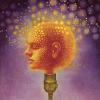I have been wondering. We practically know for sure that hippocampal neurogenesis is good, and we almost know for sure that it is good for depression, at least in certain populations. But just reading the name of this thread, it talks about synaptogenesis, not neurogenesis. Can someone who's researched it explain the difference? Can you have synaptogenesis in the absence of neurogenesis? It sounds like there will be more connections between neurons, but there's only so much neurotransmitters to go around, so will they have to be shared with more synapses. I clearly remember reading that one theory of how ECT works is by actually SEVERING connections between sections of the brain. How do we know increasing the amount of connections is a good thing?
Neurogenesis is the creation of new neurons from stem cells, synaptogenesis is the creation of new synapses between neurons. In the synaptic cleft (the gap area between synaptic knob and somas), neurotransmitters are exchanged to signal action potential.
So if NSI-189 signals the production of stem cells in the hippocampus, a chemical messenger must signal those stem cells to become new neurons. Just because a neuron is signaled to manifest, it may not necessarily have function. It must connect via dendrite, to synapse, to synaptic cleft to other functional neurons and be used with fair regularity, otherwise the neuron will likely be pruned. Similar is true of dendrites, synapses and receptor sites in terms of 'use it or lose it'.
Dihexa, according to what we are told, signals dedritic spining, and therefore synapses, of which, some should find other nerves to communicate with.
Synaptogenesis happens throughout one's life time, especially in learning, however a 'vast explosion' of syanptogenesis occurs largely in youth during the critical developmental phase as pruning is quite high. Pruning is good because it makes more efficient, your neurological network. Dihexa, in theory, gives the adult brain an artificially provoked explosion of synaptogenesis similar to that of a child.
Neurogenesis largely happens during the pre-natal period, although in adult life some neurogenesis occurs, largely in the hippocampus and subventricular zone. The reason for this is the concentration of stem cells in those areas.
I suppose, that if everything that I am reading of the drugs is correct, the sequence and schedule of drugs one would want to take to partially simulate an adolescent brain would be as follows:
1.) NSI-189 (for signaling of stem cell creation in available areas)
2.) ISX-9 (for signaling of available stem cells to neurons)
3.) Dihexa (for signaling of dendritic spines, and synapses from newly available neurons)
4.) Then the brain will do the rest in the way of pruning and reinforcement (probably good to take on new behaviors and courses of learning during this phase).
This is, of course, still a hypothesis as it's not necessarily proven that the above drugs will in fact have this action in the human brain, however data suggests they might.
Edited by sk_scientific, 27 July 2014 - 04:54 PM.

































































